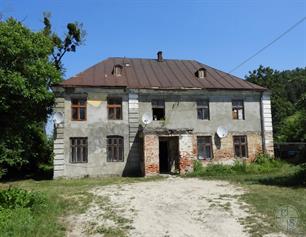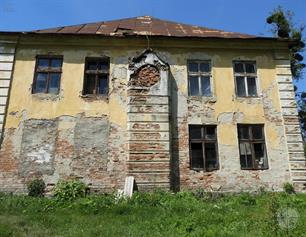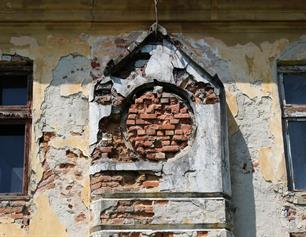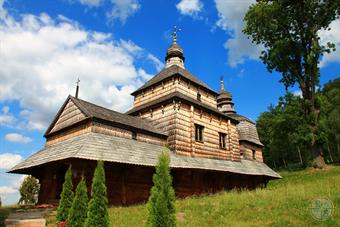Potelych
Lviv district, Lviv region
Sources:
- Russian Jewish encyclopedia
- Virtual Shtetl. Potylicz
- Słownik geograficzny Krуlestwa Polskiego i innych krajуw słowiańskich, vol. 8, F. Sulimierski, W. Walewski, B. Chlebowski (eds.), Warszawa 1881, pp. 880–881, 883
- Encyclopedia of Camps and Ghettos 1933–1945, vol. II A, Goeffrey P. Megargee (ed.), pp. 819–820.
- Encyclopedia of Jewish Life Before and During the Holocaust, vol. 2, S. Spector, G. Wigoder (eds.), New York 2001, p. 1018.
Photo:
- Eva Maria Kraiss, Center for Jewish art. Synagogue in Potelych
- Zev Radovan, Center for Jewish art. Potelych (Potylicz, Potelich)
- Wikipedia. Descent of the Holy Spirit Church
- Russian Jewish encyclopedia
- Virtual Shtetl. Potylicz
- Słownik geograficzny Krуlestwa Polskiego i innych krajуw słowiańskich, vol. 8, F. Sulimierski, W. Walewski, B. Chlebowski (eds.), Warszawa 1881, pp. 880–881, 883
- Encyclopedia of Camps and Ghettos 1933–1945, vol. II A, Goeffrey P. Megargee (ed.), pp. 819–820.
- Encyclopedia of Jewish Life Before and During the Holocaust, vol. 2, S. Spector, G. Wigoder (eds.), New York 2001, p. 1018.
Photo:
- Eva Maria Kraiss, Center for Jewish art. Synagogue in Potelych
- Zev Radovan, Center for Jewish art. Potelych (Potylicz, Potelich)
- Wikipedia. Descent of the Holy Spirit Church
In 1847, 112 Jews lived in Potelych,
in 1880 - 259 (9%),
in 1900 - 335 (10.3%),
in 1921 - 269 (8%),
in 1931 - approx. 400 Jews.
The earliest records mentioning Jewish settlers in Potelych date back to 1487. In later years, the local community was granted various trade privileges. There was a Jewish beer brewery in the town, founded at the site of the former Church of the Transfiguration of the Lord.
The residents of Potelych were obliged to pay various fees: “In accordance with their law, the townspeople pay 62 zlotys in total for squares and gardens, while the Jews pay 32 zlotys for their houses.”
At the beginning of the 17th century, Jews owned 15 houses.
Rabbi in the township at the beginning of the 17th century there was Dovid Segal. In 1870–1917, the rabbi was Menacham-Mendman Landman (1840–1917), which founded the Hasidic dynasty. After the death of M.-M. Landman, the dynasty was led by his son Izhok (1870–1942), who moved in the early 1920s. to Rava-Ruska.
In the 1920s the rabbi in Potelich was Yakov Lifshits.
For some time in Potelych was the rabbi Dawid Ben Shmuel Ha-Levi; in honor of his famous work, the Synagogue “Turey Zahaw” was subsequently named in Lviv (better known as “Golden Rose”)
In the 1920-30s departments of various Jewish parties and organizations acted in Potelych.
Unfortunately, there are no preserved sources documenting the lot of Potelych Jews during World War II. It is only known that in September 1942, the Jewish population of the town was displaced to the ghetto in Rava Ruska – after the second liquidation operation in the district, the Germans used it as an assembly point for Jews from nearby towns (eg. Magierуw, Niemirуw, Uhnуw, Lubycza Krуlewska).
The ghetto was finally liquidated between 7 and 11 December 1942 – 2,000 people were shot on the spot and 2,500 were sent to the Bełżec extermination camp.
in 1880 - 259 (9%),
in 1900 - 335 (10.3%),
in 1921 - 269 (8%),
in 1931 - approx. 400 Jews.
The earliest records mentioning Jewish settlers in Potelych date back to 1487. In later years, the local community was granted various trade privileges. There was a Jewish beer brewery in the town, founded at the site of the former Church of the Transfiguration of the Lord.
The residents of Potelych were obliged to pay various fees: “In accordance with their law, the townspeople pay 62 zlotys in total for squares and gardens, while the Jews pay 32 zlotys for their houses.”
At the beginning of the 17th century, Jews owned 15 houses.
Rabbi in the township at the beginning of the 17th century there was Dovid Segal. In 1870–1917, the rabbi was Menacham-Mendman Landman (1840–1917), which founded the Hasidic dynasty. After the death of M.-M. Landman, the dynasty was led by his son Izhok (1870–1942), who moved in the early 1920s. to Rava-Ruska.
In the 1920s the rabbi in Potelich was Yakov Lifshits.
For some time in Potelych was the rabbi Dawid Ben Shmuel Ha-Levi; in honor of his famous work, the Synagogue “Turey Zahaw” was subsequently named in Lviv (better known as “Golden Rose”)
In the 1920-30s departments of various Jewish parties and organizations acted in Potelych.
Unfortunately, there are no preserved sources documenting the lot of Potelych Jews during World War II. It is only known that in September 1942, the Jewish population of the town was displaced to the ghetto in Rava Ruska – after the second liquidation operation in the district, the Germans used it as an assembly point for Jews from nearby towns (eg. Magierуw, Niemirуw, Uhnуw, Lubycza Krуlewska).
The ghetto was finally liquidated between 7 and 11 December 1942 – 2,000 people were shot on the spot and 2,500 were sent to the Bełżec extermination camp.
A factory of porcelain acted in Potelych, on which various items were made for Jewish holidays. Photos from collection of Lviv Museum of Ethnography and Crafts, 1995.
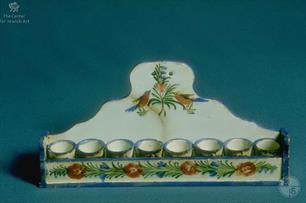 |
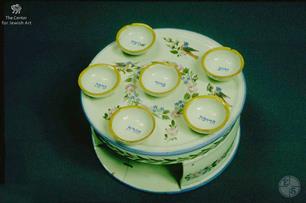 |
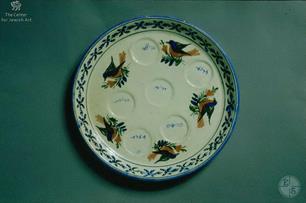 |
| Hanukkah Menorah, 1855-1911 | Two-tiered Seder plate, 1875-1911 | Seder plate, 1904 |
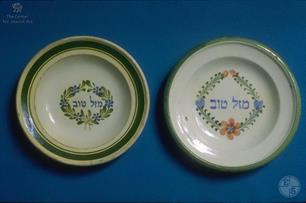 |
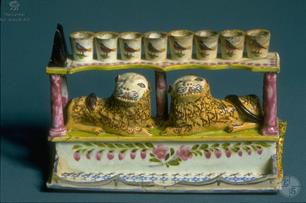 |
|
| Wedding plate, 1850-1911 | Hanukkah Menorah, 1855-1911 |
Potelych (pol. Potylicz, ukr. Потелич), village in the Lviv region. It was founded in 1430. In the 16-18 centuries - in the Russian Voivodeship as part of the Commonwealth. In the 19th-beginning of the 20th century - in the province of Galicia as part of Austria-Hungary. In 1919–39 - in the Lviv Voivodeship as part of Poland, in 1939–91 - as part of the Ukrainian SSR.
In 1498, the city of Potelych was granted Magdeburg law. Potomelich is becoming one of the large economic centers. There were famous pottery workshops, earthenware factory, brewery, distillery, mills, wax and many crafts.
In 1498, the city of Potelych was granted Magdeburg law. Potomelich is becoming one of the large economic centers. There were famous pottery workshops, earthenware factory, brewery, distillery, mills, wax and many crafts.

- Home
- Shtetls
- Vinnytsia region
- Volyn region
- Dnipro region
- Donetsk region
- Zhytomyr region
- Zakarpattia region
- Zaporizhzhia region
- Ivano-Frankivsk region
- Kyiv region
- Kropyvnytskyi region
- Luhansk region
- Lviv region
- Mykolayiv region
- Odessa region
- Poltava region
- Rivne region
- Sumy region
- Ternopil region
- Kharkiv region
- Kherson region
- Khmelnytskyi region
- Chernihiv region
- Chernivtsi region
- Cherkasy region
- Crimea
- Synagogues
- Cemeteries
- Objects & guides
- Old photos
- History
- Contact
Jewish towns of Ukraine
Jewish towns of Ukraine
My shtetl
My shtetl
Donate
